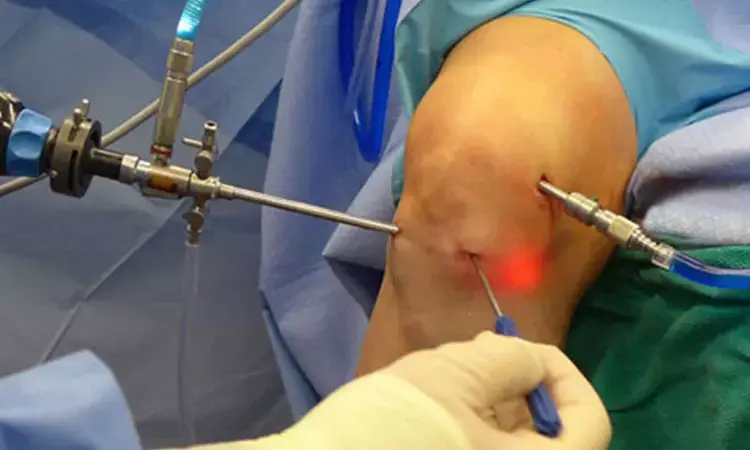- Home
- Medical news & Guidelines
- Anesthesiology
- Cardiology and CTVS
- Critical Care
- Dentistry
- Dermatology
- Diabetes and Endocrinology
- ENT
- Gastroenterology
- Medicine
- Nephrology
- Neurology
- Obstretics-Gynaecology
- Oncology
- Ophthalmology
- Orthopaedics
- Pediatrics-Neonatology
- Psychiatry
- Pulmonology
- Radiology
- Surgery
- Urology
- Laboratory Medicine
- Diet
- Nursing
- Paramedical
- Physiotherapy
- Health news
- Fact Check
- Bone Health Fact Check
- Brain Health Fact Check
- Cancer Related Fact Check
- Child Care Fact Check
- Dental and oral health fact check
- Diabetes and metabolic health fact check
- Diet and Nutrition Fact Check
- Eye and ENT Care Fact Check
- Fitness fact check
- Gut health fact check
- Heart health fact check
- Kidney health fact check
- Medical education fact check
- Men's health fact check
- Respiratory fact check
- Skin and hair care fact check
- Vaccine and Immunization fact check
- Women's health fact check
- AYUSH
- State News
- Andaman and Nicobar Islands
- Andhra Pradesh
- Arunachal Pradesh
- Assam
- Bihar
- Chandigarh
- Chattisgarh
- Dadra and Nagar Haveli
- Daman and Diu
- Delhi
- Goa
- Gujarat
- Haryana
- Himachal Pradesh
- Jammu & Kashmir
- Jharkhand
- Karnataka
- Kerala
- Ladakh
- Lakshadweep
- Madhya Pradesh
- Maharashtra
- Manipur
- Meghalaya
- Mizoram
- Nagaland
- Odisha
- Puducherry
- Punjab
- Rajasthan
- Sikkim
- Tamil Nadu
- Telangana
- Tripura
- Uttar Pradesh
- Uttrakhand
- West Bengal
- Medical Education
- Industry
Which is better- Genicular nerve block or adductor canal block for managing pain after arthroscopic knee ligament reconstruction?

Recently published study compared the analgesic efficacy of ultrasound-guided genicular nerve block (GNB) with adductor canal block (ACB) in patients undergoing arthroscopic anterior cruciate ligament reconstruction (ACLR). The randomized, double-blind study included 38 adult patients, with 19 in each group. The primary outcome was Numerical Rating Scale (NRS) pain scores over 24 hours, and the secondary outcome included the duration of analgesia and 24-hour morphine consumption. The study found that NRS scores at rest and physical activity at 24 hours were similar in both groups. The mean time to rescue analgesia and 24-hour morphine consumption was also comparable in both groups, indicating that ultrasound-guided GNB has an analgesic efficacy similar to ultrasound-guided ACB for patients undergoing arthroscopic ACLR.
Importance of Postoperative Analgesia in ACLR and Comparison of GNB and ACB -
The study emphasizes the importance of postoperative analgesia in ACLR, highlighting the benefits of early mobilization and patient satisfaction. The authors utilized US-guided GNB and ACB and found that both techniques provide comparable postoperative analgesia for ACLR patients. Although GNB provides motor-sparing and selectively blocks articular branches, the study findings suggest that it has similar analgesic efficacy to ACB, a relatively familiar technique. Additionally, the study highlighted the potential limitations, including the small sample size and high standard deviation. The authors recommended more randomized controlled trials with a larger sample size to further understand the safety and efficacy of GNB after knee surgery. Overall, the study contributes valuable insights into the analgesic efficacy of GNB and ACB for patients undergoing ACLR, indicating their comparable effectiveness in postoperative pain management.
Key Points -
- The study emphasizes the importance of postoperative analgesia in ACLR, highlighting the benefits of early mobilization and patient satisfaction. The authors utilized US-guided GNB and ACB and found that both techniques provide comparable postoperative analgesia for ACLR patients. Although GNB provides motor-sparing and selectively blocks articular branches, the study findings suggest that it has similar analgesic efficacy to ACB, a relatively familiar technique. Additionally, the study highlighted the potential limitations, including the small sample size and high standard deviation. The authors recommended more randomized controlled trials with a larger sample size to further understand the safety and efficacy of GNB after knee surgery.
- Overall, the study contributes valuable insights into the analgesic efficacy of GNB and ACB for patients undergoing ACLR, indicating their comparable effectiveness in postoperative pain management.
Reference –
Sujatha, Sandeep S. N.; Gupta, Kapil1; Guria, Sushil; Chhabra, Priyanka H.. Comparison of genicular nerve block with adductor canal block for postoperative pain management in patients undergoing arthroscopic knee ligament reconstruction: A randomised controlled trial. Indian Journal of Anaesthesia 68(5):p 454-459, May 2024. | DOI: 10.4103/ija.ija_994_23.
MBBS, MD (Anaesthesiology), FNB (Cardiac Anaesthesiology)
Dr Monish Raut is a practicing Cardiac Anesthesiologist. He completed his MBBS at Government Medical College, Nagpur, and pursued his MD in Anesthesiology at BJ Medical College, Pune. Further specializing in Cardiac Anesthesiology, Dr Raut earned his FNB in Cardiac Anesthesiology from Sir Ganga Ram Hospital, Delhi.


